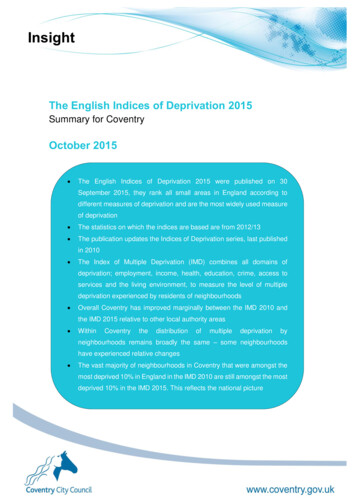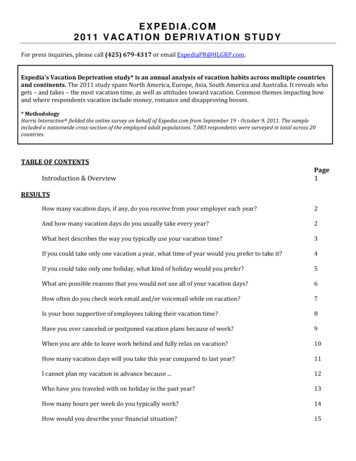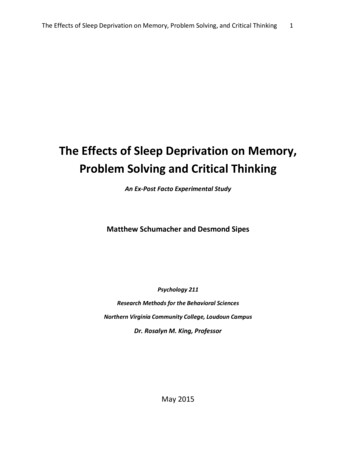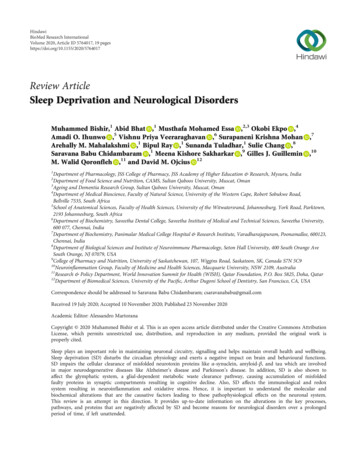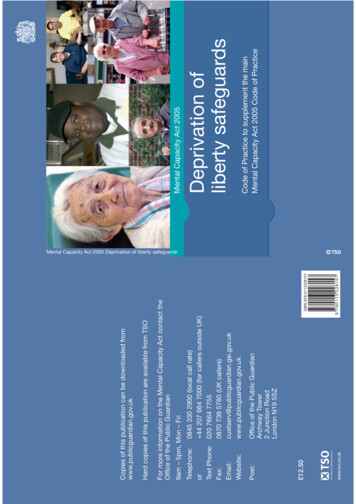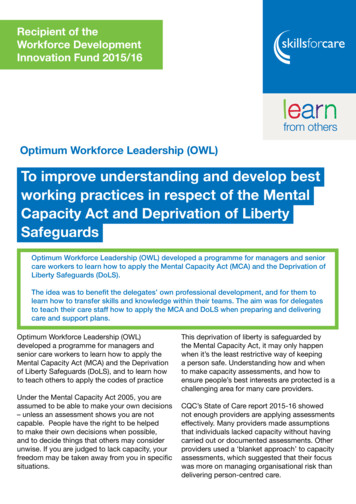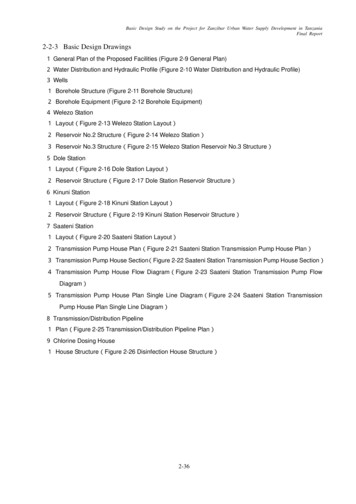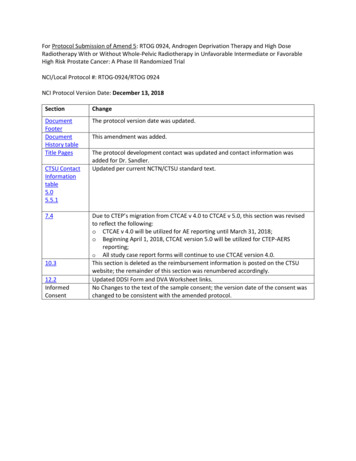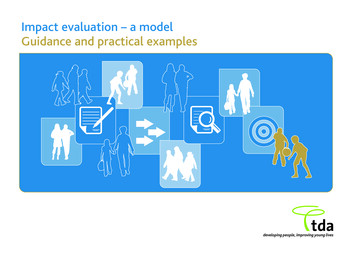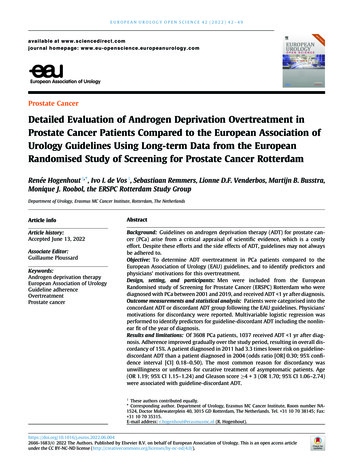
Transcription
EUROPEAN UROLOGY OPEN SCIENCE 42 (2022) 42–49available at www.sciencedirect.comjournal homepage: www.eu-openscience.europeanurology.comProstate CancerDetailed Evaluation of Androgen Deprivation Overtreatment inProstate Cancer Patients Compared to the European Association ofUrology Guidelines Using Long-term Data from the EuropeanRandomised Study of Screening for Prostate Cancer RotterdamRenée Hogenhout y,*, Ivo I. de Vos y, Sebastiaan Remmers, Lionne D.F. Venderbos, Martijn B. Busstra,Monique J. Roobol, the ERSPC Rotterdam Study GroupDepartment of Urology, Erasmus MC Cancer Institute, Rotterdam, The NetherlandsArticle infoAbstractArticle history:Accepted June 13, 2022Background: Guidelines on androgen deprivation therapy (ADT) for prostate cancer (PCa) arise from a critical appraisal of scientific evidence, which is a costlyeffort. Despite these efforts and the side effects of ADT, guidelines may not alwaysbe adhered to.Objective: To determine ADT overtreatment in PCa patients compared to theEuropean Association of Urology (EAU) guidelines, and to identify predictors andphysicians’ motivations for this overtreatment.Design, setting, and participants: Men were included from the EuropeanRandomised study of Screening for Prostate Cancer (ERSPC) Rotterdam who werediagnosed with PCa between 2001 and 2019, and received ADT 1 yr after diagnosis.Outcome measurements and statistical analysis: Patients were categorised into theconcordant ADT or discordant ADT group following the EAU guidelines. Physicians’motivations for discordancy were reported. Multivariable logistic regression wasperformed to identify predictors for guideline-discordant ADT including the nonlinear fit of the year of diagnosis.Results and limitations: Of 3608 PCa patients, 1037 received ADT 1 yr after diagnosis. Adherence improved gradually over the study period, resulting in overall discordancy of 15%. A patient diagnosed in 2011 had 3.3 times lower risk on guidelinediscordant ADT than a patient diagnosed in 2004 (odds ratio [OR] 0.30; 95% confidence interval [CI] 0.18–0.50). The most common reason for discordancy wasunwillingness or unfitness for curative treatment of asymptomatic patients. Age(OR 1.19; 95% CI 1.15–1.24) and Gleason score 4 3 (OR 1.70; 95% CI 1.06–2.74)were associated with guideline-discordant ADT.Associate Editor:Guillaume PloussardKeywords:Androgen deprivation therapyEuropean Association of UrologyGuideline adherenceOvertreatmentProstate canceryThese authors contributed equally.* Corresponding author. Department of Urology, Erasmus MC Cancer Institute, Room number NA1524, Doctor Molewaterplein 40, 3015 GD Rotterdam, The Netherlands. Tel. 31 10 70 38145; Fax: 31 10 70 35315.E-mail address: r.hogenhout@erasmusmc.nl (R. .0042666-1683/Ó 2022 The Authors. Published by Elsevier B.V. on behalf of European Association of Urology. This is an open access articleunder the CC BY-NC-ND license ).
EUROPEAN UROLOGY OPEN SCIENCE 42 (2022) 42–4943Conclusions: In a Dutch cohort, slow adaptation of the EAU guidelines on ADT forPCa patients between 2001 and 2019 resulted in overall overtreatment of 15%,mostly in asymptomatic patients who were unfit or unwilling for curative treatment. Clear, structured presentation, or integration of these tailored guidelinesinto the electronic health record might accelerate the adaptation of future guidelines.Patient summary: Slow adaptation of the guidelines on hormonal therapyresulted in overtreatment in 15% of prostate cancer patients, mostly in asymptomatic patients who were unfit or unwilling for curative treatment.Ó 2022 The Authors. Published by Elsevier B.V. on behalf of European Association ofUrology. This is an open access article under the CC BY-NC-ND license ).1. IntroductionSide effects of androgen deprivation therapy (ADT) formen with prostate cancer (PCa) can lead to reduced quality of life (QoL) [1]. Furthermore, since ADT does notimprove overall survival in some patient categories [2],a careful trade-off between harms and benefits must bemade when ADT is considered. Guidelines facilitate suchdecisions in daily clinical practice by promoting effectivetreatments and discouraging ineffective ones based onscientific research to maintain the quality of health care[3–5].The European Association of Urology (EAU) guidelineson PCa were first published in 2001 and have since beenfollowed in Dutch daily practice [6]. In general, the guidelines recommend ADT as a primary treatment for metastatic patients and as an adjuvant to radiotherapy (RT)for localised PCa. Previous research has shown thatpatients with low-risk PCa do not benefit from any formof ADT in terms of overall survival [7]. This is also truefor ADT as monotherapy in intermediate-risk and highrisk PCa patients. However, the latter is accepted by theguidelines in patients who are unwilling or unfit toundergo curative treatment, and those who are symptomatic or with high prostate-specific antigen (PSA) levelsor short PSA doubling time (PSADT). In these patients,ADT can be initiated as palliative treatment to improveQoL.Developing these guidelines is a costly effort, bothfinancially and time-wise. Despite these efforts, several studies have found adherence to the guidelinesto be suboptimal [8–11]. However, these studies didnot report on the methodology for categorisation intoguideline-concordant or guideline-discordant ADT [8,9],while for ADT as monotherapy, the aforementionedconditions should be taken into account accordingto the EAU guidelines. Furthermore, the physician’smotivation to engage in guideline-discordant behaviour in prescribing ADT remains unclear. Gaininginsight into this will be valuable to improve guideline adherence.Therefore, we assessed the ADT overtreatment in PCapatients compared to the EAU guidelines using detailedclinical data, and we identified predictors and physicians’motivation for this overtreatment.2. Patients and methods2.1.Study populationThe European Randomised study of Screening for Prostate Cancer(ERSPC) is a multicentre, randomised controlled trial that investigatesthe effect of PSA-based screening on PCa mortality. Overall ERSPC Rotterdam study characteristics have been described previously [12]. Eligible men (50–74 yr) were identified from a population register andrandomised to an intervention or control arm. Recruitment was initiatedin 1993 and lasted until 2000. All participants provided written informedconsent. Men in both study arms diagnosed with PCa were included in astudy database. At the time of diagnosis, the following information wasrecorded: date of diagnosis, urinary complaints, PSA level, Gleason score(GS), TNM classification 1992, and initial treatment. During follow-up,PSA level, events of disease progression, and current or change of treatment were monitored and recorded.For this study, we retrospectively included men from both studyarms of the ERSPC Rotterdam who were diagnosed with PCa in all stages.Since the first EAU PCa guideline was published in 2001 [13], weincluded in our analyses those who were diagnosed with PCa between2001 and 2019. To quantify the guideline adherence on ADT, all patientswho received any form of treatment with ADT within the 1st year afterdiagnosis were included. This timespan was chosen to prevent missingneoadjuvant ADT treatment to RT or surgery.2.2.Definitions of ADT useADT consisted of luteinising-hormone-releasing hormone (ant)agonists,antiandrogens, or a subcapsular orchiectomy as treatment. All uses ofADT were categorised into ADT as monotherapy, ADT combined withRT, ADT before radical prostatectomy (RP), or ADT after failed curativetreatment. When ADT was prescribed before or concomitant with RTor RP, it was defined as (neo)adjuvant therapy. ADT as monotherapyfor progression during watchful waiting was defined as palliativetherapy.2.3.Risk groupsFor categorisation into the guideline-concordant ADT group and theguideline-discordant ADT group, all men with localised PCa and metastatic PCa were identified. Localised PCa was classified using the EAUrisk group classification [6]: low-risk disease was defined as PSA 10ng/ml, GS 6, or clinical stage T1-2a; intermediate-risk disease wasdefined as PSA 10–20 ng/ml, GS 7, or clinical stage T2b; and highrisk disease was defined as PSA 20 ng/mL, GS 8, or clinical stageT2c. Men in whom GS, PSA, or clinical (c)T stage was missing wereclassified according to the remaining available clinical factors. Men
44EUROPEAN UROLOGY OPEN SCIENCE 42 (2022) 42–49diagnosed with PCa in whom information about metastasis (Mx) wasmissing were considered metastatic if PSA was 100 ng/mL [14]. Menin whom imaging did not show metastasis (M0) were also consideredmetastatic if PSA was 100 ng/mL, to make an equal assessment amongthese two groups.2.4.Classification in guideline-concordant ADT and guidelinediscordant ADTAccording to the EAU guidelines [15], all uses of ADT for distantmetastasis and palliative ADT were considered concordant. In localisedPCa, concordant use of ADT included ADT as an adjuvant to RT inintermediate-risk and high-risk groups. For men in whom ADT wasstarted with the intention to combine it with RT, but who refrainedfrom RT later on, the initial treatment proposal was used for the analysis. Any use of ADT in low-risk patients and ADT as an adjuvant toRP in any risk group was classified as guideline-discordant. We considered ADT after curative treatment (ie, RT or RP) as guidelineconcordant, since these patients may have had biochemical recurrence(BCR) or persistent PSA after surgery. ADT due to disease progressionafter initial watchful waiting was also considered as guidelineconcordant since the risk classification had changed compared to thebaseline risk.The EAU guidelines allow for ADT as monotherapy in patientswith intermediate-risk or high-risk (including locally advanced) PCaunder certain conditions. However, some conditions changed overtime (Supplementary Table 1). Since these were only minor changes,mostly for a short period, we maintained the most commonly usedcombination of conditions stated in the guidelines: ADT as monotherapy for intermediate-risk to high-risk PCa patients was consideredguideline-concordant if one was unwilling or unfit for local treatmentwhen either being symptomatic or asymptomatic with PSADT 12mo or PSA 25 ng/ml in or before 2010 and PSA 50 ng/ml after2010 (Fig. 1). In patients with lymph node metastasis, ADT asmonotherapy was unconditionally allowed until 2010, and thus weconsidered monotherapy as guideline-concordant in patients diagnosed before 2011. Thereafter, we maintained the aforementionedconditions.‘‘Symptomatic’’ is not defined by the EAU guidelines [6]. The full-Fig. 1 – Flowchart for the assessment of guideline adherence on androgendeprivation therapy as monotherapy in intermediate-risk and high-risk PCapatients. ADT androgen deprivation therapy; PCa prostate cancer;PSA prostate-specific antigen in ng/ml; PSADT PSA doubling time in ng/ml/mo. a Unfit when explicitly reported in the medical record or based onmedical history. b Unwilling when explicitly reported in the medical record.text guidelines refer to the European Organisation for Research andTreatment of Cancer study that established criteria for initiatingADT, including description of symptoms [7]. Based on this study,we scored evidence of ureteric obstruction (ie, hydronephrosis), urethral obstruction with severe consequences (ie, urinary retention), orlocal rectal obstruction (ie, paradoxical diarrhoea) caused by the pri-experience in PCa care. Cases without agreement were discussed toreach a consensus.mary tumour as ‘‘symptomatic’’. Since lower urinary tract symptoms(LUTS) are quite common among men in the same age category as2.6.Statistical analysisthe study population due to causes other than PCa (eg, benign prostatic hyperplasia), this condition was not classified as ‘‘symptomatic’’. ‘‘Unwilling’’ or ‘‘unfit’’ was positively scored (Fig. 1) whenit was explicitly reported in the medical record. When not explicitlyreported, unfit was scored based on the reported medical history.When none of the conditions could be extracted from the medicalrecord, we considered the prescription for guideline-discordant ADTas not motivated.To assess guideline adherence on ADT and the physician’s rationale todeviate from the guidelines, descriptive statistics were quantified withcontinuous variables, presented as median (interquartile range), and categorical variables, presented as proportions (%). Multivariable logisticregression was performed to assess the relation between guidelinediscordant ADT and the age of diagnosis, the binary transformation ofPSA at diagnosis, cT stage (cT1, cT2), GS (3 3, 3 4, and 4 3),and the year of diagnosis since 2001. Missing values were imputed. Non-2.5.Medical record reviewlinearity of the predictor ‘‘years of diagnosis’’ was taken into accountusing restricted cubic splines and was quantified as the differenceDetails concerning symptomatic disease, unfitness or unwillingness, andbetween the 75th percentile and the 25th percentile. For this analysis,the physician’s rationale to deviate from the guideline were retrospec-only those at risk of guideline-discordant ADT were included (ie, mentively collected by a medical record review. A flowchart was used for awith localised PCa without disease progression or BCR, regardless ofstandardised assessment in patients with intermediate-risk and high-whether they were prescribed ADT). We assumed that men not treatedrisk PCa who received ADT monotherapy (Fig. 1). Chart reviews werewith ADT were treated correctly compared to the guideline. All statisti-independently performed by two authors who are medical doctors withcal analyses were performed using R version 4.1.0 [16].
45EUROPEAN UROLOGY OPEN SCIENCE 42 (2022) 42–493. Results3.1.Patient characteristicsBetween 2001 and 2019, a total of 3608 men were diagnosed with PCa (Table 1). Within the 1st year after diagnosis, 1037 (29%) men received ADT. Most of these men werediagnosed with high-risk PCa (49%).3.2.Guideline discordancy and rationaleOf all men enrolled, 159 (15%) received guidelinediscordant ADT (Tables 1 and 2). In every risk group, mostdiscordancy was related to ADT as monotherapy. In 30(3.5%) patients, adherence could not be evaluated due tomissing information in the medical record.The most frequent reason for guideline-discordant ADTas monotherapy was unfitness for curative treatment inabsence of symptoms, PSA 50 ng/ml, or PSADT 12 mo(Fig. 2). In 24%, motivation was not reported or could notbe inferred from the medical record. The most frequent reason for ADT prior to RP was pending the scheduled RP, witha most common waiting period of 1 mo (maximum 4 mo).Guideline-discordant ADT adjuvant to RT was mostly prescribed to achieve volume reduction of the prostate.3.3.Multivariable logistic regressionMultivariable logistic regression showed that patients whowere older or had GS 4 3 were significantly more likelyto receive guideline-discordant ADT (Table 3). The nonlinearrelation between the year of diagnosis and discordancyshowed an increase in the risk of discordancy in the first 4yr and a decrease in the years thereafter (Fig. 3). To elaborate, a patient diagnosed in 2011 (75th percentile) had a3.3 times lower risk of guideline-discordant ADT than apatient with the same risk diagnosed in 2004 (25thpercentile).Table 1 – Patient characteristics and given treatmentNo. of patients, nNot assessable, nAge (yr), median (IQR)PSA (ng/ml) overall, median (IQR)Year of diagnosis, median (IQR)Clinical stage, n (%) T1CT2AT2BT2CT3AT3BT4TXNodal stage, n (%)N0N1NxMetastatic, n (%)M0M1MxGleason score, n (%) 3 33 44 3 4 4UnknownRisk groups, n (%)Low riskIntermediate riskHigh riskLymph node metastasisDistant metastasisTreatment, n (%)ADT monotherapyAdjuvant ADT with RTAdjuvant ADT with RPADT after curative treatmentADT due to disease progressionNo ADTAll men at risk for discordant ADTaConcordantDiscordantSMD (95% CI)b27433073.0 (68.7–76.5)7.7 (4.4–14.4)2007 (2004–2011)848NA75.6 (71.5–80.0)32.0 (12.6–111.3)2008 (2004–2012)159NA79.1 (75.1–81.6)18.1 (8.1–31.6)2008 (2004–2012)NA 0.428 ( 0.60, 0.26)0.364 (0.19, 0.53)0.123 ( 0.05, 0.29)1695 (62)482 (18)141 (5.1)76 (2.8)201 (7.3)94 (2.8)25 (0.9)29 (1.1)172 (20)81 (9.6)66 (7.8)58 (6.8)203 (24)138 (16)99 (12)31 (3.7)70 (44)34 (21)12 (7.5)9 (5.7)16 (10)11 (6.9)5 (3.1)2 (1.3) 0.53 ( 0.69, 0.35) 0.33 ( 0.50, 0.16)0.01 ( 0.16, 0.18)0.05 ( 0.12, 0.22)0.38 (0.21, 0.55)0.30 (0.13, 0.47)0.33 (0.16, 0.5)0.16 ( 0.01, 0.32)NANANA316 (37)121 (14)411 (48)45 (28)10 (6.3)104 (65)0.19 (0.02, 0.36)0.27 (0.10, 0.43) 0.34 ( 0.52, 0.18)NANANA358 (42)309 (36)181 (21)80 (50)NA79 (50) 0.16 ( 0.33, 0.01)1.07 (0.89, 1.25) 0.62 ( 0.79, 0.45)1631 (59)476 (17)184 (6.7)362 (13)90 (3.3)111 (13)158 (19)115 (14)383 (45)81 (9.6)53 (33)34 (21)19 (12)44 (28)9 (5.7) 0.50 ( .67, 0.33) 0.05 ( 0.22, 0.12)0.07 ( 0.10, 0.24)0.43 (0.26, 0.60)0.15 ( 0.02, 0.32)1191 (43)717 (26)835 (30)NANA10 (1.2)77 (9.1)393 (46)59 (7.0)309 (36)31 (19)27 (17)91 (57)10 (6.3)0 (0) 0.63 ( 0.80, 0.46) 0.24 ( 0.41, 0.07) 0.22, ( 0.39, 0.05)0.03 ( 0.14, 0.20)1.07 (0.89, 1.25)205 (7.5)380 (14)7 (0.3)NANA2151 (78)426 (50)382 (45)0 (0)19 (2.2)21 (2.5)NA144 (91)8 (5.0)7 (4.4)0 (0)0 (0)NA 0.98 ( 1.16, 0.81)1.04 (0.87, 1.22) 0.47 ( 0.30, 0.13)0.21 (0.04, 0.38)0.23 (0.06, 0.40)NAADT androgen deprivation therapy; CI confidence interval; IQR interquartile range; NA not available; PCa prostate cancer; PSA prostate-specificantigen; RP radical prostatectomy; RT radiotherapy; SMD standardised mean difference.aAll men with localised PCa regardless of whether they were prescribed ADT.bSMD between concordant and discordant.
46EUROPEAN UROLOGY OPEN SCIENCE 42 (2022) 42–49Table 2 – Frequency of guideline-concordant versus guidelinediscordant ADT according to the EAU guidelines stratified by riskgroup (n 1037)Low-risk PCa, n (%)ADT monotherapyAdjuvant ADT with RTAdjuvant ADT with RPADT after curative treatmentADT due to progression of diseaseIntermediate-risk PCa, n (%)ADT monotherapyAdjuvant ADT with RTNeoadjuvant ADT with RPADT after curative treatmentADT due to progression of diseaseHigh-risk PCa, n (%)ADT monotherapyAdjuvant ADT with RTNeoadjuvant ADT with RPADT after curative treatmentADT due to progression of diseaseLymph node metastasis, n (%)ADT monotherapyAdjuvant ADT with RTNeoadjuvant ADT with RPADT after curative treatmentADT due to progression of diseaseDistant metastasis, n (%)Not assessable, n (%)Concordant848 (82%)Discordant159 (15%)10 (12)NANANA5 (50)5 (50)77 (9.1)2 (3.9)63 (82)NA5 (6.5)7 (9.1)393 (46)70 (18)309 (79)NA8 (2.0)7 (1.8)59 (7.0)48 (81)9 (15)NA1 (1.7)1 (1.7)309 (37)30 (3.5)31 (19)21 (68)8 (26)2 (6.5)NANA27 (17)25 (93)NA2 (7.4)NANA91 (57)88 (97)NA3 (3.3)NANA10 (6.3)10 (100)NA0 (0)NANANAADT androgen deprivation therapy; EAU European Association ofUrology; PCa prostate cancer; RP radical prostatectomy;RT radiotherapy.4. DiscussionThe benefit of ADT for men with PCa in terms of treatmentof symptoms and improving survival must be balancedagainst its side effects. Although evidence-based clinicalpractice guidelines assist in these decisions, guidelineadherence is suboptimal according to previous studies [8–11]. To our knowledge, this is the first study that investigated ADT overtreatment compared to the EAU guidelinesover a long period (ie, 19 yr) and by using detailed dataon patient preferences and symptoms. This study is alsounique as it is the first to report the physicians’ rationalefor guideline-discordant prescription of ADT in the cohortin question.We found that adherence to the EAU guidelines gradually improved over the study period, resulting in overallovertreatment of 15%, mostly because of unjustified ADTas monotherapy. The most frequently reported motivationfor guideline-discordant ADT was unwillingness or unfitness of patients for curative treatment without havingsymptoms or other reasons such as high PSA level or shortPSADT. This is remarkable given that these conditions forjustified ADT prescription were described by the guidelines.One way to potentially accelerate the guideline adherencecould be a visual structured presentation of these criteria,for example, in flowcharts, as was done for this study(Fig. 1), instead of text boxes to avoid the conditions beingneglected unconsciously. A possibly more effective way toimprove guideline adherence could be obtained throughthe emerging clinical decision support systems [17]. Theseknowledge-based systems enable the integration of guidelines into the electronic health record, eliminating continuous guideline consultation in everyday practice. However,despite promising examples, individualised tailoring is sofar limited by the rigid algorithms of these systems.Unfitness as the most commonly reported motivation forguideline-discordant ADT prescription is reflected by ahigher age that was found to be significantly related toADT overtreatment, which is also reported by previousresearch [8]. In addition, in line with our findings, Morgiaet al [9] did not find PSA to be predictive for guidelinediscordant ADT according to the EAU guidelines, possiblybecause in some men ADT prescription is justified by highPSA levels. For higher GSs ( 4 3), we found a significantrelation to ADT overtreatment compared to GS 3 3. Thiscould be explained by the fact that in low-risk men, prescription of any ADT is always discordant, whereas ADTfor intermediate-risk and high-risk patients is concordantunder conditions mentioned earlier. This conditional justification of ADT prescription poses a risk for guidelinediscordant behaviour, especially when these conditionsare not clearly presented by the guidelines or need to beactively searched for (ie, outside the electronic healthrecord).Besides PSA, Morgia et al. [9] did not find a relation withthe year of diagnosis. However, this study had a relativelyshort study period (ie, 2 yr). We were able to explore theguideline adherence over a longer period since we includedpatients between 2001 and 2019. After the first 4 yr,patients were more likely to receive guideline-concordantADT when diagnosed more recently. An explanation for thiscould be the time and effort it takes before a new guidelinebecomes widely known, and subsequently, common practice, emphasising the importance of dissemination of guidelines at, for example, national and internationalconferences. In addition to the implementation of theguidelines in daily clinical practice, rising awareness ofthe side effects of ADT over the past decades might havealso influenced guideline adherence over time. Around2002, the negative impact of ADT on cognition came tothe attention [18]. In 2006, an increased risk of diabetesand cardiovascular disease was found [19,20] and confirmed by subsequent studies [21]. In addition, more recentstudies showed an increased risk of dementia [22]. Other,better known side effects of ADT are sexual dysfunction,gynaecomastia, fatigue, hot flashes, and anaemia [19]. Theyall potentially decrease the QoL and should, therefore, notbe ignored.Given the broad spectrum of side effects, the remedy canbe worse than the disease, especially in asymptomatic men.Therefore, the guidelines allow for ADT as monotherapy inmen with localised PCa only when having symptoms, highPSA levels or short PSADT [15]. LUTS, which is commonamong these men, could be one of those symptoms, especially at a locally advanced PCa stage. There is no specificmention of this issue in the EAU guidelines. However,regardless of whether LUTS should be classified as symptomatic, sometimes less invasive options for treating LUTScould be considered, such as alpha-blockers, 5-alphareductase inhibitors (palliative), transurethral resection of
47EUROPEAN UROLOGY OPEN SCIENCE 42 (2022) 42–49Fig. 2 – Physician’s motivations for guideline-discordant androgen deprivation therapy. ADT androgen deprivation therapy; LUTS lower urinary tractsymptoms; PSA prostate-specific antigen in ng/ml; PSADT PSA doubling time in ng/ml/mo; RP radical prostatectomy; RT radiotherapy; T stage tumourstage.the prostate, or (self-)catheterisation. The same applies tovolume reduction to enable RT, which was a common rationale for guideline-discordant prescription of ADT in combination with RT in this study.The present study has some limitations. First, the EAUguidelines changed over time, which made the assessmentdifficult. However, no major changes occurred. Somechanges were included in the analysis (eg, ADT monotherapy in lymph node metastasis before 2010), but taking intoaccount the subtle changes would have significantlyincreased the complexity of the analysis without clinicallyrelevant consequences. Additionally, the assessment of thephysician’s motivation for discordancy was retrospectivelycollected. Since the arguments to prescribe ADT were notalways explicitly or consistently reported by the physiciansin the medical records, some assessments were subject tointerpretation. For example, for 25% (39/159) of men whoreceived guideline-discordant ADT, motivation for subscription was not reported by the physician (Fig. 2) but mighthave been discussed orally with the patient. Furthermore,Table 3 – Multivariable logistic regression of guideline-discordantADTAge (yr)Year of diagnosis25th percentile (2004)75th percentile (2011)Binary transformation of PSA (ng/ml)T stageT1 T2Gleason score 63 4 4 3OR (95% CI)p value1.19 (1.15–1.24) 0.001Reference0.30 (0.18–0.50)1.10 (0.97–1.24)0.0140.13Reference1.45 (1.00–2.10)0.052Reference1.43 (0.85–2.40)1.70 (1.06–2.74)0.180.029ADT androgen deprivation therapy; CI confidence interval;PSA prostate-specific antigen; OR odds ratio.the analysis is partly based on assumptions (ie, definitionof symptomatic, metastatic if PSA 100 ng/ml, and concordance in men who were not prescribed ADT). However, to
48EUROPEAN UROLOGY OPEN SCIENCE 42 (2022) 42–49Fig. 3 – Predicted probability of guideline-discordant androgen deprivation therapy per year for a patient with median PSA, median age at diagnosis, cT2, andGleason score 3 4. A patient diagnosed in 2011 (right orange square, 75th percentile) had a 3.3 times lower risk of guideline-discordant ADT than a patientwith the same risk diagnosed in 2004 (left orange square, 25th percentile). ADT androgen deprivation therapy; PSA prostate-specific antigen.create consistency and minimise subjectivity, we standardised the assessment using a flowchart. Besides, all medicalrecords were independently assessed by two authors, anda consensus was reached by face-to-face discussions.Another aspect to keep in mind is that even though thiswas a multicentre study, our cohort consisted mainly ofpatients from Rotterdam and surrounding areas. Since previous research found geographical areas to be predictive ofguideline-discordant ADT [9], our findings may not reflectguideline adherence in other regions of the Netherlands orEurope. Additionally, we only assessed overtreatment withADT compared to the guidelines among PCa patients.Another interesting aspect to focus on would be undertreatment, and to distinguish between intermittent ADT andcontinuous ADT. Therefore, we await the results of the ongoing comprehensive EAU Guidelines Office IMAGINE project, which maps ADT practice patterns in a more extensiveway across Europe to improve guideline adherence [23].resulted in overall overtreatment of 15% between 2001and 2019. Reasons for overtreatment with andorgen deprivation therapy were unfitness or unwillingness of thepatient for curative treatment, high PSA levels, or shortPSA doubling time, pending radical prostatectomy, andprostate volume reduction prior to radiotherapy. Clear,structured flowcharts in guidelines or, more promising,integration of these tailored guidelines into the electronichealth record is needed to accelerate the adaptation offuture guidelines.Author contributions: Renée Hogenhout had full access to all the data inthe study and takes responsibility for the integrity of the data and theaccuracy of the data analysis.Study concept and design: Hogenhout, de Vos, Remmers, Venderbos, Busstra, Roobol.Acquisition of data: Hogenhout, de Vos, ERSPC Rotterdam Study Group.Analysis and interpretation of data: Hogenhout, de Vos, Remmers.5. ConclusionsDrafting of the manuscript: Hogenhout, de Vos.Critical revision of the manuscript for important intellectual content:Hogenhout, de Vos, Remmers, Venderbos, Busstra, Roobol.In a Dutch cohort, slow adaptation of the EAU guidelines onandrogen deprivation therapy for prostate cancer patientsStatistical analysis: de Vos, Remmers.Obtaining funding: None.
EUROPEAN UROLOGY OPEN SCIENCE 42 (2022) 42–49Administrative, technical, or material support: Hogenhout, de Vos,Remmers.Supervision: Roobol.[9]Other: None.Financial disclosures: Renée Hogenhout certifies that all conflicts of[10]interest, including specific financial interests and relationships and affiliations relevant to the subject matter or materials discussed in the manuscript (eg, employment/affiliation, grants or funding, consultancies,[11]honoraria, stock ownership or options, expert testimony, royalties, orpatents filed, received, or pending), are the following: None.[12]Funding/Support and role of the sponsor: None.[13]Appendix A. Supplementary data[14]Supplementary data to this article can be found online References[16][1] Dacal K, Sereika SM, Greenspan SL. Quality of life in prostate cancerpatients taking androgen deprivation therapy. J Am Geriatr Soc2006;54:85–90.[2] Gupta M, Patel HD, Schwen ZR, Tran PT, Partin AW. Adjuvantradiation with androgen-deprivation therapy for men with lymphnode metas
Background: Guidelines on androgen deprivation therapy (ADT) for prostate can-cer (PCa) arise from a critical appraisal of scientific evidence, which is a costly effort. Despite these efforts and the side effects of ADT, guidelines may not always . Department of Urology, Erasmus MC Cancer Institute, Room number NA-1524, Doctor Molewaterplein .
